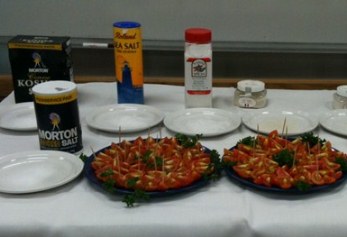Lesson Plan: Adding a “Salt Tasting” to your Curriculum
Super UserBy Colin Roche, MBA, CEC, CCE, FMP, CHE
 Teaching the vast range of salts helps students in product-identification, nutrition and many other classes.
Teaching the vast range of salts helps students in product-identification, nutrition and many other classes.
Universally, the most common seasoning used on food is the mineral sodium chloride (NaCl), or salt, which comes in a wide variety of forms. Salt heightens flavor by enhancing natural base ingredients and has a stronger taste on cooler foods than on hot foods. It must be added carefully, though, because the taste of saltiness cannot be removed, and it does not burn off during the cooking process.
The Lesson
Most students today have no idea of the vast variety of salts available in the market or the varying and distinct flavors that each type has. To them, salt is salt, with a similar taste. Considering that growing up most people are only exposed to basic table salt, this opinion is to be expected.
At Johnson & Wales University, we like to expose our students to a variety of different salts in their freshman year. This not only includes seeing, touching and tasting them, but also involves discussions on the different flavors, costs and applications of the various salts.
We currently do our salt tasting with our freshman students in our purchasing and product-identification class; however, I can see this lesson being appropriate in a variety of classes, including both hot and cold kitchen classes such as garde manger, international cuisine and nutrition courses.
Salt Types and Descriptions
- Table salt is the most common type of salt used in food preparation. Its fine granules contain additives, iodine and anti-caking agents, to keep the salt free-flowing.
- Rock salt is available in edible and non-edible forms. Often used as a non-food-grade salt, it is employed primarily to make ice cream or for other freezing techniques. It may also be used as a cooking bed for clams and oysters.
- Sea salt is derived from the evaporation of seawater. This type of salt is often preferred because of its strong, intense and distinctive flavor. Sea salt comes in fine and coarse crystals.
- Kosher salt is a type of purified rock salt void of additives and iodine, which is often used interchangeably with table salt. Available in coarse form, it is used in the koshering of, or for extracting blood from, meat.
- Pickling salt is finely crystallized salt that is void of additives. It blends easily with the pickling solution.
- Specialty salts, or designer salts, including la fleur de sel (“the flower of the salt”), are available through specialty food purveyors. There are several varieties of specialty salts such as:
Hawaiian salt is an unrefined sea salt, pink to brown in color and rich in iron oxide.
French sea salt (sel marin/la fleur de sel) is commercially available, and range in texture, color and in crystal size. It comes from natural seawater that is pooled in basins and then evaporated.
Danish smoked salt is a darker salt with a distinctive smoky flavor. It is made in the Viking tradition by evaporating seawater to produce a salt that is cooked over firewood of juniper, oak and other hard woods.
Peruvian pink salt comes from an underground ocean that feeds springs high in the Andes Mountains. The salt owes its color to the rose quartz that lines the sides of wells.
Lesson Objectives
- Define what salt is.
- Describe and explain the differences between various salts.
- Taste different salts.
- Describe the flavors and qualities of various salts.
- Share how various salts may be used in the foodservice industry.
- Reflect on the tasting of various salts.
The Tasting
Set up a table with various salts on it in their original containers. In front of each container, place a plate and pour out some of each salt onto it. You will then need a vehicle to taste the salts with. We use toothpick-skewered cherry tomatoes that have been cut in half. Whatever your tasting medium is, put it on a platter and then onto your tasting table.
At JWU Miami campus, we currently have our students taste the following salts in this order: 1. Kosher salt. 2. Sea salt. 3. Italian sea salt. 4. Sel gris. 5. Fleur de sel. 5. Hawaiian red clay salt. 6. Hawaiian black lava salt. 7. Smoked sea salt. 8. Dulse granules. 10. MSG. And last we have them taste 11. Iodized salt.
Step 1: Gather the students and have them look at the salts. Identify each salt by name and give a brief description and its approximate cost.
Step 2: Next, have each student pick up a halved cherry tomato with a toothpick, and one by one, have them taste each salt in order.
Step 3: After the students have tasted each salt, stop and get them to describe the taste and their general overall thoughts on the salt.
Step 4: When the last salt has been tasted, engage the students in a discussion on the differences among the salts, including flavors and costs, and then ask them to suggest possible uses for each of the salts.
Colin Roche, MBA, CEC, CCE, FMP, CHE, is department chair at the College of Culinary Arts at the North Miami campus of Johnson & Wales University, as well as an assistant professor teaching a variety of culinary and hospitality courses.
Leave a comment
Make sure you enter all the required information, indicated by an asterisk (*). HTML code is not allowed.

